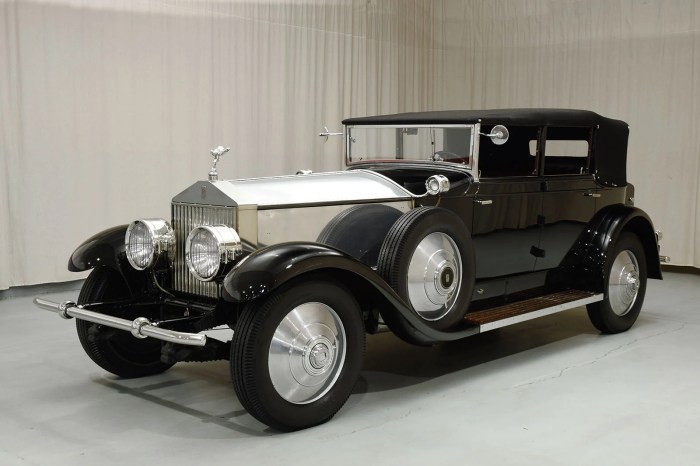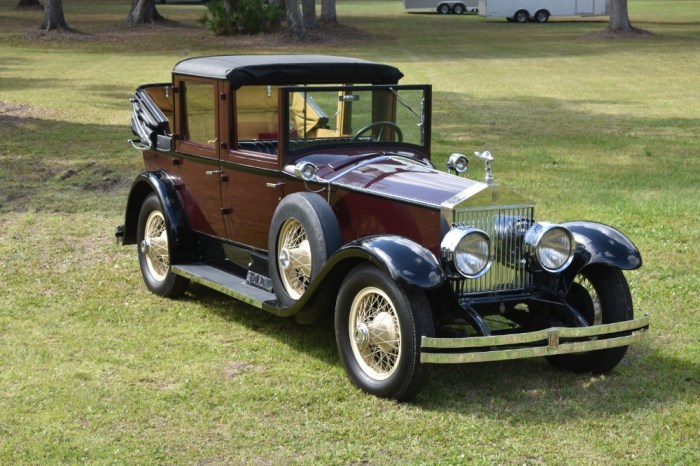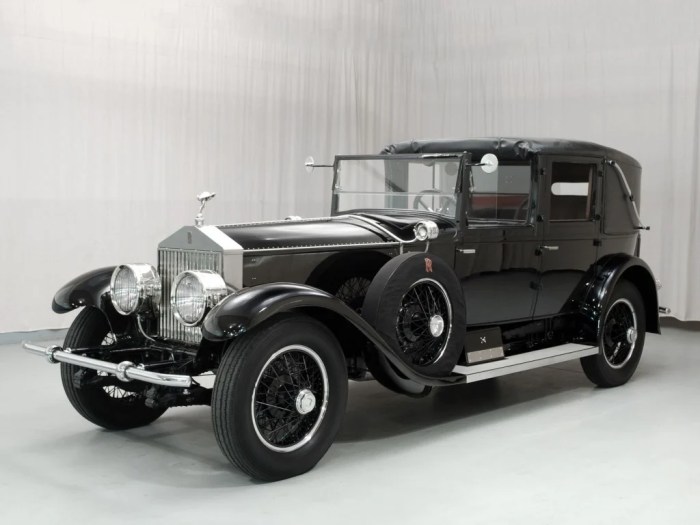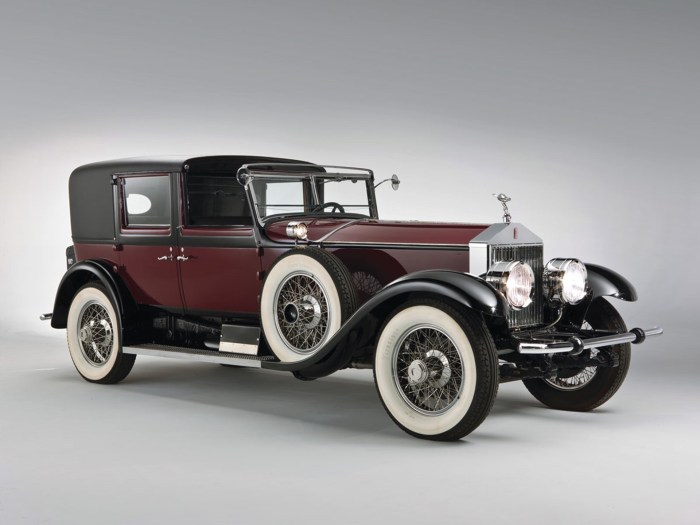The 1928 Rolls-Royce Phantom, a name synonymous with opulence and engineering brilliance, emerged as a defining moment in the marque’s history. This iconic automobile, a masterpiece of design and craftsmanship, redefined luxury travel for the elite, setting a standard that continues to inspire automotive design today.
The Phantom’s sleek, elegant lines, meticulously crafted interior, and powerful engine made it a symbol of prestige and power. Its introduction marked a pivotal moment in the evolution of the Rolls-Royce brand, solidifying its position as the ultimate symbol of luxury and engineering excellence.
History and Background
The 1928 Rolls-Royce Phantom, known as the Phantom I, marked a significant milestone in the history of the iconic British marque. It was the first Rolls-Royce Phantom to be produced after the death of Charles Rolls in 1910, and it represented a significant departure from the pre-war models.
It introduced several innovations that would define the Rolls-Royce Phantom for years to come.The Phantom I emerged at a time when the world was recovering from the First World War. Rolls-Royce was eager to reassert its position as the leading luxury car manufacturer, and the Phantom I was their answer.
It was a statement of opulence, power, and engineering excellence.
Design Features
The 1928 Phantom I was characterized by its imposing size and luxurious design. It was a large, heavy car, with a wheelbase of 144 inches and a length of over 20 feet. The bodywork was typically built by independent coachbuilders, who were given a great deal of freedom to express their creativity.
This resulted in a wide variety of body styles, ranging from elegant sedans to imposing limousines.
Key design features included:
- A large, imposing radiator grille with a distinctive Rolls-Royce “Spirit of Ecstasy” mascot.
- A spacious, luxurious interior with high-quality materials and craftsmanship.
- A distinctive, sloping hood that gave the Phantom I a distinctive profile.
Technological Advancements
The 1928 Phantom I also featured a number of technological advancements that made it one of the most advanced cars of its time.
These advancements included:
- A powerful 7.6-liter six-cylinder engine, producing 100 horsepower, which was a significant improvement over the engines used in previous Rolls-Royce models.
- A new four-wheel braking system that provided improved stopping power and safety.
- A robust chassis that was designed to handle the car’s weight and power.
Design and Aesthetics

The 1928 Rolls-Royce Phantom, a masterpiece of automotive engineering, was not only a testament to technological prowess but also a symbol of elegance and refinement. Its design, both exterior and interior, embodied the spirit of the era, reflecting the opulence and sophistication of the Roaring Twenties.
Exterior Design
The Phantom’s exterior design was a study in classic elegance. Its long, flowing lines, reminiscent of the streamlined aesthetic of the time, exuded an air of effortless grace. The car’s imposing size, with a wheelbase of 144 inches and an overall length of 208 inches, commanded attention wherever it went.
The Phantom’s distinctive radiator grille, with its vertical vanes and the iconic Spirit of Ecstasy hood ornament, became synonymous with Rolls-Royce.
Interior Design
The interior of the 1928 Phantom was a sanctuary of luxury and comfort. The finest materials were used throughout, including Connolly leather for the upholstery, walnut for the dashboard and trim, and Wilton carpets for the floor. The seating arrangements were designed for maximum comfort, with spacious accommodations for six passengers.
The Phantom’s interior featured a range of unique features, such as a fold-down picnic table, a vanity mirror, and a built-in clock.
Craftsmanship and Attention to Detail
The 1928 Phantom was a testament to the meticulous craftsmanship of Rolls-Royce. Every aspect of the car, from the hand-stitched leather upholstery to the intricate wood veneer, was crafted with the utmost care and precision. The attention to detail was evident in every aspect of the car’s design, from the placement of the door handles to the shape of the headlamps.
The Phantom’s engineers and artisans were dedicated to creating a car that was not only beautiful but also functional and durable.
Performance and Engineering

The 1928 Rolls-Royce Phantom was a technological marvel for its time, boasting a powerful engine and a refined driving experience that set a new standard for luxury automobiles. Its engineering prowess was a testament to the meticulous craftsmanship and attention to detail that defined Rolls-Royce.
Engine Specifications and Performance
The 1928 Phantom was powered by a 7.6-liter, six-cylinder engine, a significant departure from the earlier 4-cylinder models. This engine, known as the “Phantom I” engine, generated a respectable 105 horsepower at 2,400 rpm. While this may seem modest by today’s standards, it was a substantial power output for the era.
The engine was renowned for its smooth operation, thanks to its innovative design featuring a cast-iron block and aluminum cylinder head. The engine’s torque, however, was even more impressive, providing ample power for effortless acceleration and a comfortable cruising speed.The 1928 Phantom’s performance was impressive for its time.
It could achieve a top speed of around 80 miles per hour, making it one of the fastest cars on the road. Its acceleration was also noteworthy, reaching 60 mph in approximately 25 seconds. While these figures may seem pedestrian today, they were exceptional for a car of that era.
Driving Experience and Handling
The driving experience in a 1928 Rolls-Royce Phantom was a testament to the brand’s dedication to luxury and comfort. The car was known for its smooth ride, thanks to its robust chassis and sophisticated suspension system. The suspension, featuring semi-elliptic leaf springs, effectively absorbed bumps and uneven road surfaces, providing a luxurious and serene driving experience.
The Phantom’s handling was also commendable, considering its size and weight. The steering was precise and responsive, allowing for confident maneuvering, and the brakes, though mechanical, provided adequate stopping power for the time. The car’s large size and long wheelbase contributed to a stable and predictable handling characteristic.
Performance Compared to Contemporary Automobiles
The 1928 Rolls-Royce Phantom stood out among its contemporaries in terms of performance and refinement. While other luxury cars of the era, such as the Mercedes-Benz 630 and the Cadillac LaSalle, offered impressive power and handling, the Phantom’s combination of luxury, performance, and engineering excellence set it apart.
Its smooth engine, comfortable ride, and refined handling made it a true symbol of automotive luxury.
Cultural Impact and Legacy
The 1928 Rolls-Royce Phantom, a pinnacle of automotive luxury and engineering, left an indelible mark on society, becoming more than just a car; it symbolized an era, a lifestyle, and a cultural shift. Its impact extended far beyond the realm of transportation, influencing popular culture, design aesthetics, and the very perception of automotive excellence.
Notable Figures and Events
The 1928 Phantom was a favorite among the elite, with its presence gracing many significant events and being associated with notable figures. It became a symbol of wealth and status, driven by royalty, celebrities, and influential business tycoons.
- King George V of England, known for his love of Rolls-Royce, owned several Phantoms, including a 1928 model. This association further solidified the car’s image as a royal chariot.
- The 1928 Phantom was a common sight at glamorous events like the Henley Royal Regatta, the Wimbledon Championships, and the Ascot Races, where it transported the upper crust of society.
- Hollywood stars, including Charlie Chaplin and Douglas Fairbanks, were known to own and be chauffeured in the 1928 Phantom, further cementing its status as a symbol of Hollywood glamour.
Impact on Popular Culture and Automotive Design
The 1928 Phantom’s sleek design, luxurious interior, and powerful engine influenced not just the automotive industry but also popular culture, shaping the perception of luxury and elegance.
- The car’s distinctive radiator grille, with its iconic Spirit of Ecstasy hood ornament, became a symbol of automotive refinement, inspiring countless imitations and influencing car design for decades to come.
- The 1928 Phantom’s luxurious interior, with its plush leather upholstery, intricate wood paneling, and advanced amenities, set the standard for automotive luxury, influencing interior design trends in cars and other industries.
- The 1928 Phantom’s performance and engineering prowess, showcasing its smooth and silent operation, inspired other manufacturers to strive for similar levels of refinement and engineering excellence.
Enduring Legacy in the Automotive World
The 1928 Rolls-Royce Phantom’s legacy continues to resonate in the automotive world today. Its influence can be seen in modern Rolls-Royce models, which retain the brand’s commitment to luxury, craftsmanship, and engineering excellence.
- The Phantom’s distinctive design cues, such as the Spirit of Ecstasy hood ornament and the signature radiator grille, are still present in contemporary Rolls-Royce models, serving as a visual link to the brand’s rich heritage.
- The Phantom’s emphasis on luxurious materials, intricate detailing, and meticulous craftsmanship continues to inspire Rolls-Royce’s commitment to providing unparalleled levels of comfort and refinement in its vehicles.
- The 1928 Phantom’s legacy of engineering excellence has paved the way for Rolls-Royce to continue pushing the boundaries of automotive technology, producing cars that are not only luxurious but also powerful and technologically advanced.
Notable Examples and Variations: 1928 Rolls-Royce Phantom

The 1928 Rolls-Royce Phantom, a pinnacle of luxury and engineering, spawned numerous remarkable examples and variations that reflected the diverse needs and tastes of its affluent clientele. From custom-bodied masterpieces to unique engine configurations, these vehicles embody the unparalleled craftsmanship and bespoke nature of Rolls-Royce.
The 1928 Rolls-Royce Phantom, a masterpiece of automotive engineering, embodied the luxury and prestige of its era. While the Phantom reigned supreme in the late 1920s, the automotive landscape evolved, and Rolls-Royce introduced the 1950 Rolls-Royce Silver Wraith as a successor, further pushing the boundaries of automotive excellence.
Both models, however, remain timeless symbols of opulence and sophistication, captivating car enthusiasts even today.
Notable Examples
The 1928 Rolls-Royce Phantom was a canvas for bespoke creations, and many examples stand out for their unique features and historical significance. Here are a few notable instances:
| Example | Unique Features | Historical Significance |
|---|---|---|
| The “Phantom I” owned by King George V | Custom-bodied by Barker, featuring a spacious seven-passenger saloon with an extended wheelbase and a distinctive royal livery. | A symbol of royal prestige and a testament to the Phantom’s role as a preferred choice for heads of state and dignitaries. |
| The “Phantom I” owned by J.P. Morgan | An elegant coupe with a sleek, streamlined body designed by Hooper, showcasing the Phantom’s adaptability to different body styles. | A testament to the Phantom’s appeal to prominent figures in finance and industry, demonstrating its association with wealth and influence. |
| The “Phantom I” owned by the Maharaja of Mysore | A lavish limousine with a custom-built body by Gurney Nutting, featuring opulent interiors with intricate details and a distinctive Maharaja-inspired color scheme. | A showcase of the Phantom’s ability to cater to the extravagant tastes of royalty and high society, emphasizing its role as a symbol of luxury and grandeur. |
Variations
The 1928 Rolls-Royce Phantom offered various variations, catering to different preferences and driving needs. These variations primarily involved body styles, engine options, and customization.
| Variation | Body Style | Engine Options | Customization |
|---|---|---|---|
| Standard Saloon | Four-door sedan with a spacious interior and ample luggage space. | 6.7-liter, 6-cylinder engine with a power output of 100 bhp. | Extensive customization options, including interior upholstery, exterior paint, and bespoke features. |
| Coupé | Two-door coupe with a sleek, streamlined body and a more sporting character. | 6.7-liter, 6-cylinder engine with a power output of 100 bhp. | Customization options included sporty wheel designs, streamlined bodywork, and high-performance engine tuning. |
| Limousine | Extended wheelbase sedan with a spacious interior and a luxurious rear passenger compartment. | 6.7-liter, 6-cylinder engine with a power output of 100 bhp. | Customization options included opulent interiors with fine wood veneers, leather upholstery, and bespoke accessories. |
Restoration and Preservation

Restoring a 1928 Rolls-Royce Phantom is a complex and rewarding endeavor that requires a deep understanding of the vehicle’s history, design, and engineering. This process involves meticulous attention to detail, specialized skills, and a commitment to preserving the car’s historical authenticity.
Challenges and Complexities of Restoration
Restoring a 1928 Rolls-Royce Phantom presents numerous challenges due to the vehicle’s age and the intricate nature of its construction. The most significant challenges include:
- Finding Original Parts:Sourcing original parts can be extremely difficult, as many are no longer in production and require extensive searching through specialist suppliers, vintage car parts dealers, and even private collections.
- Material Sourcing:Obtaining the correct materials, such as leather, wood, and fabrics, that match the original specifications can be a challenge. These materials must meet the same quality standards as the originals, ensuring a faithful restoration.
- Technical Expertise:Restoring a 1928 Phantom requires specialized technical expertise, including knowledge of vintage engine technology, chassis construction, and bodywork repair techniques. This often involves working with experienced mechanics and bodywork specialists who have a deep understanding of classic cars.
- Corrosion and Deterioration:After decades of use and exposure to the elements, many components may have suffered from corrosion, deterioration, or wear and tear. Addressing these issues requires careful assessment, specialized restoration techniques, and sometimes even fabrication of replacement parts.
- Preserving Historical Authenticity:A crucial aspect of restoration is preserving the vehicle’s historical authenticity. This involves carefully documenting the original specifications, using appropriate restoration methods, and avoiding unnecessary modifications or upgrades that might detract from the car’s historical significance.
Techniques and Expertise for Preservation, 1928 Rolls-Royce Phantom
Preserving the historical authenticity of a 1928 Rolls-Royce Phantom is paramount for any restoration project. This involves employing techniques and expertise that ensure the car retains its original character and value.
- Documentation and Research:Thorough documentation and research are essential for understanding the car’s original specifications, including engine size, chassis number, body style, and any unique features. This information is vital for guiding the restoration process and ensuring accuracy.
- Expert Craftsmanship:Restoration requires skilled craftsmen who are experienced in working with vintage materials and techniques. These specialists include engine rebuilders, bodywork specialists, upholstery experts, and paint technicians who can restore the car to its former glory while maintaining its historical authenticity.
- Original Parts and Materials:Whenever possible, restoration should prioritize using original parts and materials. This ensures that the car retains its original character and that the restoration process is as faithful as possible to the original design and specifications.
- Preservation of Patina:In some cases, preserving the car’s patina, which refers to the natural aging and wear of the vehicle, can enhance its historical value. This involves carefully cleaning and preserving the original paint, leather, and other surfaces, rather than attempting to restore them to a pristine condition.
- Proper Storage and Maintenance:Once restored, a 1928 Rolls-Royce Phantom requires proper storage and maintenance to preserve its condition. This includes keeping the car in a climate-controlled environment, regularly servicing the engine and mechanical systems, and protecting the paint and upholstery from damage.
Key Components and Parts
Restoring a 1928 Rolls-Royce Phantom involves working with numerous components and parts, each requiring specialized attention and expertise. Here’s a table outlining some of the key components involved in a restoration project:
| Component | Description | Restoration Considerations |
|---|---|---|
| Engine | A large, powerful six-cylinder engine with a displacement of 7.67 liters | Overhaul, rebuild, or replacement of worn components, including pistons, connecting rods, crankshaft, and valves. |
| Transmission | A four-speed manual transmission | Complete overhaul, including replacement of worn gears, bearings, and synchromesh components. |
| Chassis | A rigid, ladder-frame chassis with a live rear axle | Restoration of the frame, suspension components, brakes, and steering system. |
| Bodywork | A handcrafted steel body with a distinctive design | Repair of any rust or damage, restoration of the original paint, and replacement of any missing or damaged trim. |
| Interior | Luxurious leather upholstery, wood trim, and various accessories | Reupholstery, restoration of wood trim, and replacement of any missing or damaged accessories. |
Modern Relevance

The 1928 Rolls-Royce Phantom, a timeless masterpiece of automotive engineering, continues to hold a significant place in the hearts of collectors, enthusiasts, and designers alike. Its enduring appeal lies in its exceptional craftsmanship, luxurious appointments, and unparalleled performance, which continue to inspire modern automotive design and technology.
Influence on Modern Automotive Design
The 1928 Phantom’s influence on modern automotive design is undeniable. Its elegant lines, flowing curves, and meticulous attention to detail have inspired countless designers throughout the years. For example, the iconic “Spirit of Ecstasy” hood ornament, a symbol of Rolls-Royce’s prestige and luxury, has become a timeless design element that continues to grace the hoods of modern Rolls-Royce vehicles.
Additionally, the Phantom’s emphasis on handcrafted quality and bespoke customization has paved the way for the modern luxury car market, where personalization and attention to detail are paramount.
The Phantom’s Legacy in Luxury Automobiles
The 1928 Phantom’s legacy as a luxury automobile is deeply rooted in its reputation for opulence, comfort, and performance. Its spacious interior, featuring luxurious leather upholstery, intricate wood veneers, and advanced technology for its time, set a new standard for automotive luxury.
The Phantom’s powerful engine and smooth handling provided a driving experience that was both exhilarating and refined, further cementing its status as a symbol of automotive excellence. This legacy continues to influence modern luxury car manufacturers, who strive to emulate the Phantom’s blend of sophistication, performance, and craftsmanship in their own vehicles.
Ultimate Conclusion

The 1928 Rolls-Royce Phantom, more than just a car, stands as a testament to a bygone era of elegance and craftsmanship. Its enduring legacy continues to captivate enthusiasts and collectors alike, reminding us of the timeless appeal of exquisite design, unparalleled performance, and the enduring allure of a true automotive icon.